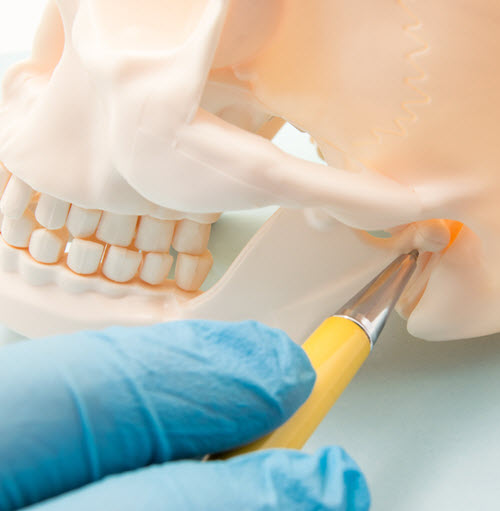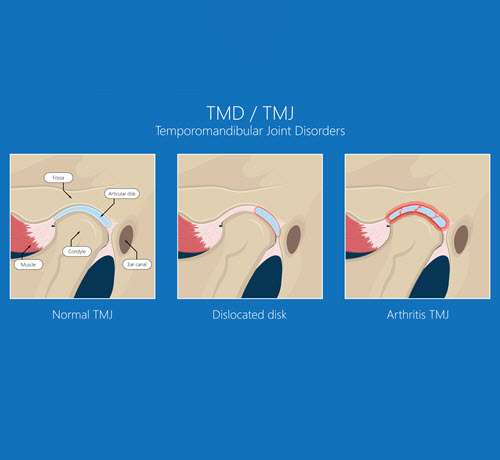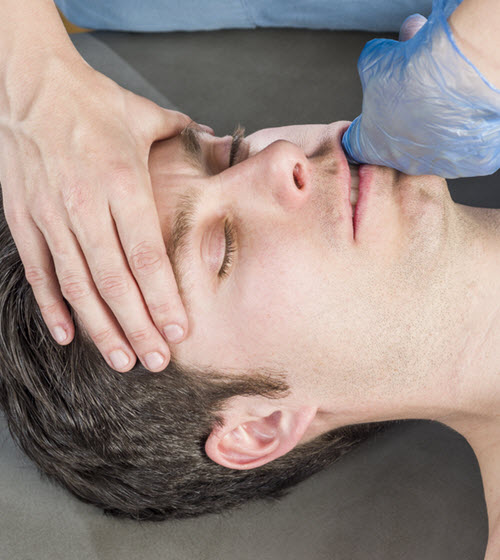“Help, I have TMJ!”
My head hurts.
My jaw locks and clicks, and sometimes I feel spasms.
I’m grinding my teeth – even in my sleep.
Once, I even woke my partner.
Well, take heart… we all do!
The term TMJ isn’t a disorder in and of itself. It’s simply an acronym that stands for “temporo-mandibular joint.”
Your TMJ is comprised of your temporal bones and your mandible (jawbone).
When we talk about TMJ disorders, we’re referring to a generalized category of conditions and symptoms that have to do with the jaw.
One of the most common is bruxism, or teeth-grinding.
When it occurs at night, doctors classify it as a sleep disorder. In fact, it’s highly correlated with sleep-disordered breathing conditions such as sleep apnea.

Why Is This Happening to Me?
A variety of muscles and soft tissue comprise and influence your TMJ.
Are you stressed?
Have you experienced trauma?
Do you have sleep apnea?
All these can cause the muscles of the TMJ to develop trigger points, pain, or spasms, typically felt when you chew and close your mouth.
They can also cause clicking or tracking problems when you open or close your jaw – annoying at the least – terribly painful at the worst.
You Need to Regain Your Balance.
If you’ve developed these problems, imbalances in the tension of the muscles of the TMJ are often the culprits.
You see, your TMJ has a tiny cartilage disc that absorbs friction and allows for smooth movement in all directions.
When you have imbalances, that disc can slip out of place.
But there’s good news: we can often drastically improve – or even completely eliminate – these issues with targeted soft tissue treatment.

Sometimes, a little is all it takes.
Because of the TMJ’s close relationship to many of other bones of the cranium, a bit of myofascial release followed by some gentle mobilization and manual realignment of these bones may be all you need.
This is especially true if you have little to no pain –
And if clicking and tracking of the jaw are your primary concerns.
Or, perhaps, you need a more direct approach.
If you have significant jaw pain, then the key may lie in direct treatment to the muscles of the TMJ.
Sometimes, we can do this by simple external massage of your big, workhorse chewing muscles.

Other times, we have to go deeper to find relief.
And it’s necessary to work inside your mouth – to allow me to accurately and thoroughly treat your TMJ at a level external treatment can’t reach.
But don’t worry.
For this type of work, I always wear disposable nitrile gloves and treat very carefully.
Trigger points in the jaw muscles can be very sensitive, and often just a little pressure goes a long way.
Helping these neglected tissues reset their pain threshold and release excess tension can often give you significant relief.
It’s not uncommon for me to finish working on one side of the mouth and have a patient exclaim, “Wow, I feel such a huge difference between the two sides!”
Once we treat the tight muscles and release any trigger points we find, I might perform some light mobilizations of the jaw to stretch the tissues, help release any remaining adhesions, and bring your jaw back into proper alignment.
And there it is.
Ahhhhhhh! Relief!
At this point, you should notice a significant difference.
Little to no pain.
Few, if any, clicking or tracking issues.
Yes!

Time for change.
If any problems persist, or if they return after a few hours or days, then it is a good indicator that we need to address another part of the body, as well, before your body is able to adapt to the change.
And this may surprise you –
In these cases, it is often necessary to work on aligning and mobilizing the hips, as the hips and jaw have a very close relationship with one another.
Solve the Mystery.
TMJ disorders are often a puzzle to patients and practitioners alike, but they don’t have to be!
All you need is a therapist who understands the structures involved and how to treat them in a way that acknowledges and respects their relationship to the rest of your body.
Ready to feel better?
Reach out to me (267) 415-6003. Let’s get to work and get you back in sync today!

